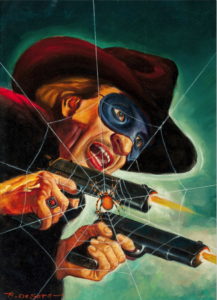
The Spider was a pulp hero who rivaled The Shadow for popularity in the 1930s and 1940s. If any pulp character could be described as “blood and thunder” this would be the guy. Nearly every adventure was a frenzy of blood and death. And fans of the magazine series had every right to wonder, “how did it all start?” In the first adventure, way back in 1933, The Spider appeared fully formed for the most part, and although hints of his early years were dropped, much was left unspoken.
What was Richard Wentworth‘s first exploit as The Spider? How did he meet his faithful companion Ram Singh? These were probably the two biggest questions, and they were finally answered in 1942 in issues number 104 and 105. Rather than publish a full-length novel to answer these two questions, they appeared in two short stories published in the back of the magazine. Both were written by regular Spider author Norvell W. Page, and helped fill in the gap in The Spider’s back-story.
‘The Wings of Kali’
“The Wings of Kali” was originally published in the back pages of the May 1942 issue of The Spider Magazine, as a companion to the full-length novel “The Spider and the Death Piper.” Yes, readers got two Spider stories that month. During college, Richard Wentworth determined upon his career of service, and he undertook a strenuous mental and physical preparation for his work. In pursuit of this, he came eventually to India… and it was there that The Spider performed his first mission.
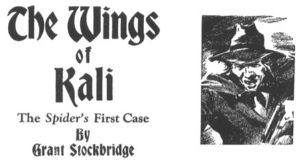
As a short story, this doesn’t have the over-the-top action and weird-menace thrills of the full-length novels. At 2,600 words, it can’t… there’s not enough room. But it’s still a mighty good story, even at that abbreviated length. If you’ve always wondered about Richard Wentworth’s first adventure as The Spider, you can wonder no more. Now it is told.
The story opens in Benares, India, at the exclusive Beano Club. Now don’t laugh… the anti-flatulence medicine of the same name didn’t come along until 1990. The name was a perfectly respectable one in 1942 when this was written. Okay, if you have to snicker a little, get it out of your system before reading on.
At the Beano Club (now stop that) a young Richard Wentworth overhears a conversation between Melissa James, a young woman, and Walter Bishop, an overbearing government official. She wants to break off their relationship. He threatens to have her passport revoked if she doesn’t stay with him.
Wentworth intervenes and aggravates the man to the point where he rushes off to arrange for Wentworth’s assassination. Wentworth leaves a strange bracelet with Melissa James. When Bishop returns to the table, he sees the bracelet and reacts oddly. Melissa tells him that someone threw it to the table from the palms, as per Wentworth’s instructions.
Wentworth climbs to the roof, throws a knife down to their table. It sticks in the center. Bishop, the coward that he is, flees. It seems the bracelet was once warn by Bishop’s slave girl whom he had killed. The knife was the weapon used. Bishop now realizes that someone knows his secret.
Wentworth escorts the young woman home in his car. Along the way they are attacked and Wentworth successfully repels the thugs. Later, Wentworth parks and leaves Melissa alone in the car while he “goes for a walk.” It’s a trap, of course, with Melissa as bait.
Bishop shows up and demands to know where Wentworth is. From out of the night comes sudden laughter. Halfway up the front of a building, a curiously hunched figure, sails out toward them… from its shoulders, a cape flutters like black wings. It howls in Hindustani, “Death on the wings of Kali.”
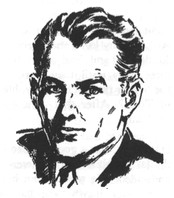
Yes, this is the first appearance of The Spider!
The sight of this bizarre figure scares off three hooded men who were crouched, hiding. Bishop calls to his assassins to return. He shoots at them. One turns and throws a knife… Bishop falls, the knife in his throat.
The swooping black figure is gone. The Spider, although he wasn’t identified by name, has disappeared into the night. Shortly thereafter, Wentworth returns. He has had a delightful “walk.” Melissa James is now safe. The end.
For such a short story, there’s a lot that actually happens. And at the same time, there is enough room to give a nice atmospheric touch to the story. You can feel the night heat of India, the smells, the sounds.
Where Wentworth got the ideas for the cape or the curious hunched shape are not explained. He just appears in the outfit. I would have liked to get a bit more background on how he got his costume, and when he chose it over other possible ones. But alas, no. The story is brief and doesn’t permit those details.
One interesting touch was during the earlier attack upon Wentworth and Melissa by a dozen thugs. How does he repel them? With young suckling pigs! Wentworth jerks open the rumble seat of his car and begins flinging the pigs into the face of his assailants. They turn and flee, howling in fright. He explains later that the touch of a pig renders these Mohammedans unclean, and they dare not be killed while unclean, so they had to retreat. An amusing touch that I appreciated.
And now for a look at the other Spider origin story.
‘Blood Bond’
“Blood Bond” was originally published in the back pages of the June 1942 issue of The Spider Magazine. “Revolt of the Underworld” was the main Spider story that month — it was another two-fer for lucky readers. In this short story, you’ll learn how Richard Wentworth first met that proud and doughty warrior, Ram Singh, and how a Sikh of the royal line (which in the Punjab means, actually, priestly line) could become the servant of a westerner.

This story, while short, is a bit longer than the one in the previous month’s magazine. Its 3,600-word length allows for a bit more action, and thus makes a more exciting tale. I really enjoyed it, although the ending was a bit confusing, with Ram Singh more interested in killing Wentworth than in serving him. But I get ahead of myself.
The story opens in the high mountain passes that climb toward the Himalayas. Although it’s spring in the Punjab, it’s still bitter cold. Snow blankets the country. Wentworth is climbing toward the far mountains in a blizzard.
He is heading toward the lamasery where he intends to spend years studying under the holy man Mar-lar-delan. Wentworth is not interested in learning psychic and spiritual powers. Instead, he wishes to learn from these masters the art of self control… the complete subjugation of the physical self to the commands of the will. Wentworth knows that absolute control is necessary for a man who has started on the trail of justice.
Wentworth’s train is attacked by marauding cut-throat Sikhs. Wentworth returns fire. Most of his party is either slain or flees from the threat. He sends the remaining member of his party back to the village they had left… a village where Govind Singh is the priest.
He waits, alone, sheltered in a cranny. Rescue comes barely in time, in the form of a party from the village, including the son of Govind Singh, one Ram Singh. There’s bad blood between Ram Singh and Richard Wentworth. He had wanted to fight and kill Wentworth, but now he has to save him from the marauders. And he does.
As the story ends, Ram Singh has permission to follow Wentworth so that he can eventually slay him:
“I shall kill thee!” Ram Singh roars.
Wentworth nods to him gravely. “I will read you the future, Oh warrior lion. You will not kill me, but save my life, many times, and it shall be my happy privilege to do the same for you. I see that we shall fight side by side against many enemies, and they shall not stand against us.”
In a few of The Spider pulp novels, reference is made to this. Ram Singh reminds Wentworth that some day he shall kill him. Until then, they work together… admire each other. It’s a complicated relationship.
Does this story take place before or after the first appearance of The Spider, as told in the previous month’s magazine? It’s not specified. It would seem to me that this one takes place earlier, however. Wentworth is on his way to study the art of self control with the holy men of Tibet. And that took several years. If I read it correctly, then, it was after completing his study with Mar-lar-delan that he had his adventure in Benares and first wore the cloak of The Spider. But since Ram Singh didn’t appear in the earlier story, it could have happened the other way around.
It’s an exciting and fun story for one so short. Many Spider fans may wonder how the two men originally met, and this story now puts it down in writing for them. It’s a worthy origin story, even though it does leave some tantalizing loose ends. Recommended for all Spider enthusiasts.
The final verdict.
Both of these stories are aimed directly at The Spider fans. They are not intended to be an introduction to the series, for those who have never read a Spider story. Actually, a newbie would probably not appreciate them. Rather, they are meant to be enjoyed by those readers who know and love The Spider, and who want some background history on the character. And in that respect both these short stories succeed admirably.
If you’ve never read a Spider story, save these two short stories for later. But if you’ve read more than five or six Spider pulp adventures, you’ll find these two short stories most interesting. And for you, I would strongly recommend them.
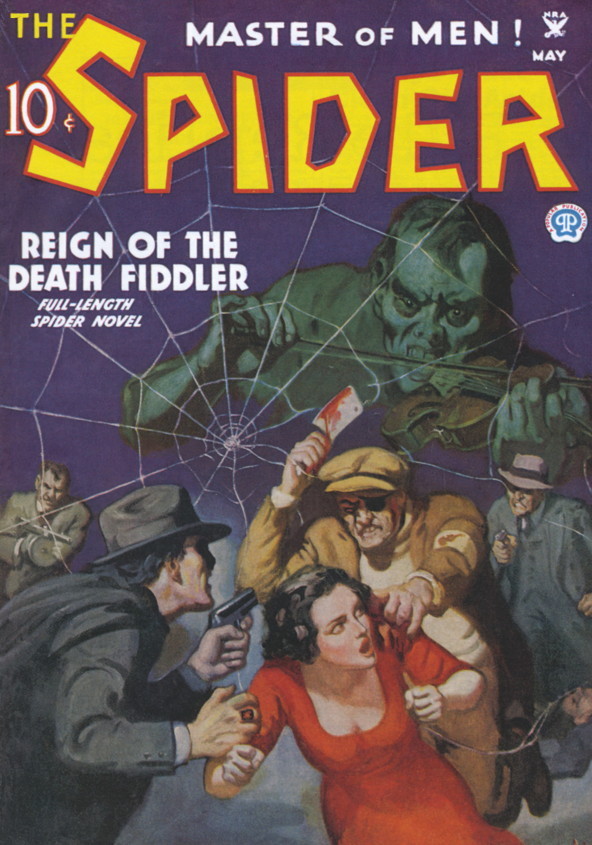
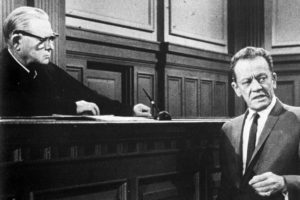

I’ve only read 2 Spider stories (in reprints), so perhaps I’m not ready for these yet, but your summary is sufficient for now. Thank you.
I hope you enjoyed the two Spider adventures that you have read. Admittedly, although most are very good, there are some duds in the bunch. I always think of the Spider as The Shadow on steroids. And I do love The Shadow.
You are lucky that every Spider story is available in inexpensive reprints, both as physical books and as ebooks. It’s a great time to be a pulp fan!
Love the painting at the top of the review. (And the ring… makes you wonder if he was an agent if the Sh… oh, never mind.)
Isn’t that painting great? It’s how I visualize the Spider when I read the stories. Always ready to deal swift and deadly justice to lawbreakers.
As to the ring, note that the design is the same one that they were selling for $0.25 through the magazine. “Kids, get yours today!” It was undoubtedly a bit of cross-promotion, having that ring in the illustration. “For only twenty-five cents, you can have a ring just like the Spider wears!”
I know I would have sent in a quarter, that’s for sure. I have purchased some of the more recent replicas… but no way could I afford one of the originals. They’re selling for thousands of dollars. I love the Spider, but not that much.